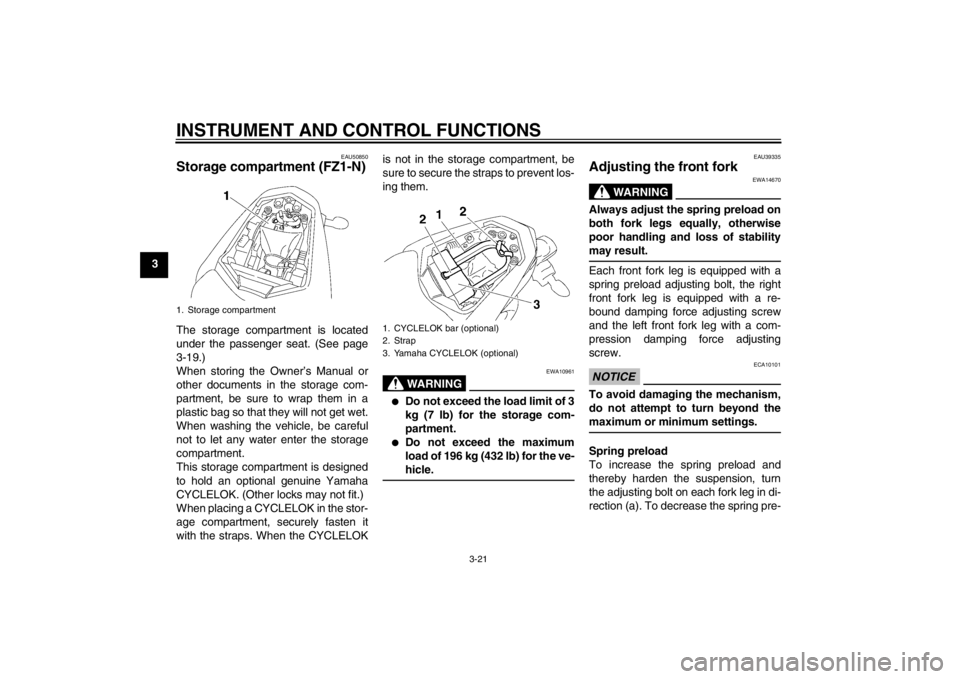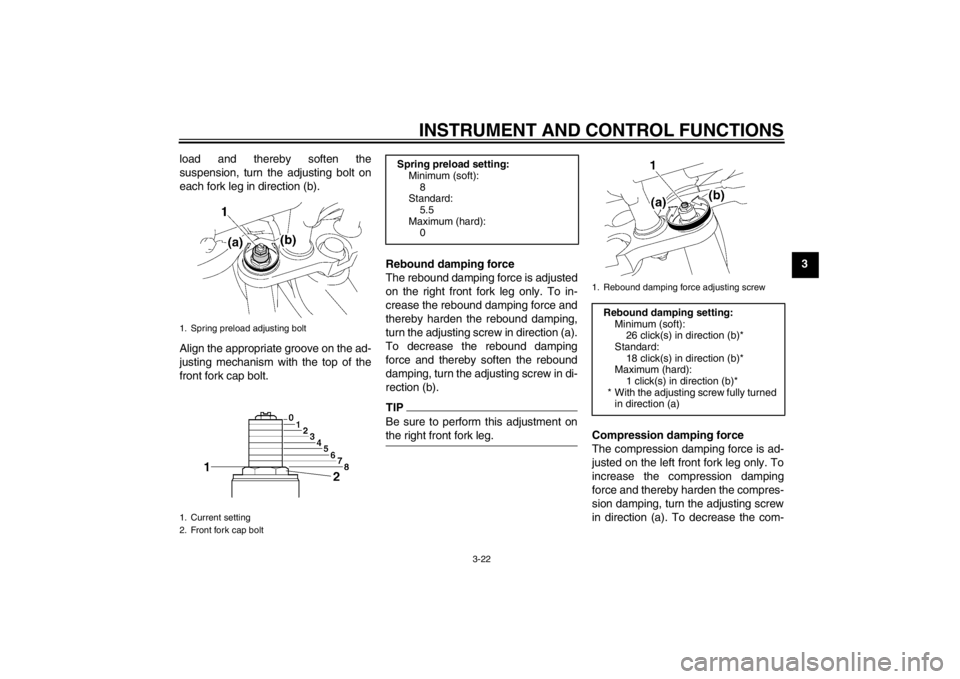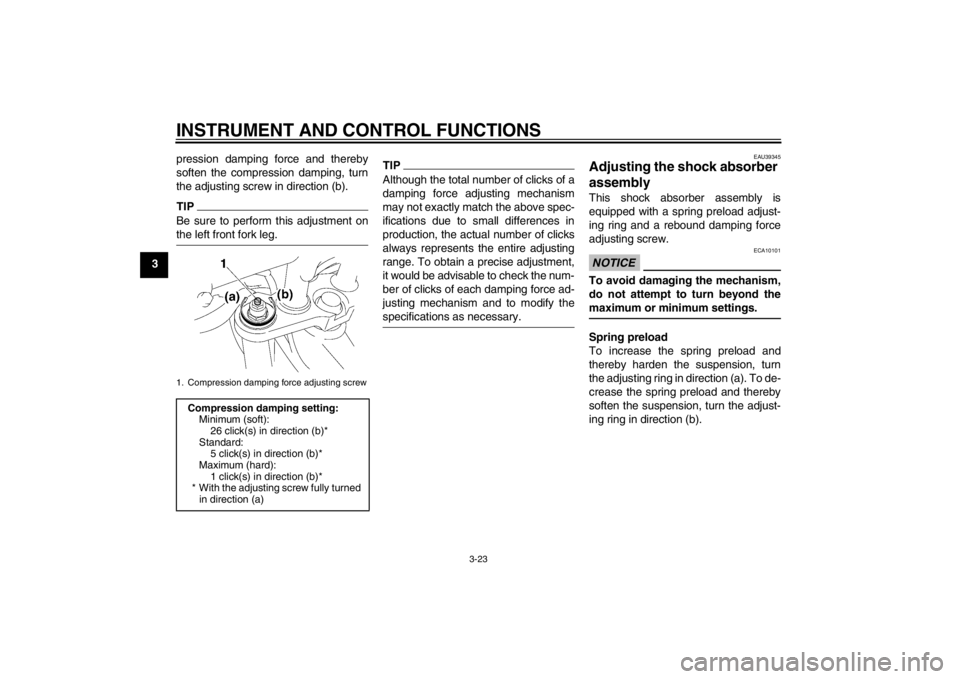2012 YAMAHA FZ1-N suspension
[x] Cancel search: suspensionPage 10 of 106

SAFETY INFORMATION
1-3
1
●
Do not run engine in poorly venti-
lated or partially enclosed areas
such as barns, garages, or car-
ports.
●
Do not run engine outdoors where
engine exhaust can be drawn into
a building through openings such
as windows and doors.
Loading
Adding accessories or cargo to your
motorcycle can adversely affect stabili-
ty and handling if the weight distribution
of the motorcycle is changed. To avoid
the possibility of an accident, use ex-
treme caution when adding cargo or
accessories to your motorcycle. Use
extra care when riding a motorcycle
that has added cargo or accessories.
Here, along with the information about
accessories below, are some general
guidelines to follow if loading cargo to
your motorcycle:
The total weight of the operator, pas-
senger, accessories and cargo must
not exceed the maximum load limit.
Operation of an overloaded vehicle
could cause an accident. When loading within this weight limit,
keep the following in mind:
●
Cargo and accessory weight
should be kept as low and close to
the motorcycle as possible. Se-
curely pack your heaviest items as
close to the center of the vehicle as
possible and make sure to distrib-
ute the weight as evenly as possi-
ble on both sides of the motorcycle
to minimize imbalance or instabili-
ty.
●
Shifting weights can create a sud-
den imbalance. Make sure that ac-
cessories and cargo are securely
attached to the motorcycle before
riding. Check accessory mounts
and cargo restraints frequently.
Properly adjust the suspension for your load (suspension-ad-
justable models only), and
check the condition and pres-
sure of your tires. Never attach any large or heavy
items to the handlebar, front
fork, or front fender. These
items, including such cargo as
sleeping bags, duffel bags, or
tents, can create unstable han-
dling or a slow steering re-
sponse.
●
This vehicle is not designed to
pull a trailer or to be attached to
a sidecar.
Genuine Yamaha Accessories
Choosing accessories for your vehicle
is an important decision. Genuine
Yamaha accessories, which are avail- able only from a Yamaha dealer, have
been designed, tested, and approved
by Yamaha for use on your vehicle.
Many companies with no connection to
Yamaha manufacture parts and acces- sories or offer other modifications for
Yamaha vehicles. Yamaha is not in a position to test the products that these
aftermarket companies produce.
Therefore, Yamaha can neither en-
dorse nor recommend the use of ac-
cessories not sold by Yamaha or
Maximum load: FZ1-N 196 kg (432 lb)
FZ1-NA 189 kg (417 lb)
U1ECE1E0.book Page 3 Monday, August 8, 2011 11:52 AM
Page 11 of 106

SAFETY INFORMATION
1-4
1
modifications not specifically recom-
mended by Yamaha, even if sold and
installed by a Yamaha dealer.
Aftermarket Parts, Accessories, and
Modifications
While you may find aftermarket prod-
ucts similar in design and quality to
genuine Yamaha accessories, recog-
nize that some aftermarket accessories
or modifications are not suitable be-
cause of potential safety hazards to you
or others. Installing aftermarket prod-
ucts or having other modifications per-
formed to your vehicle that change any
of the vehicle’s design or operation
characteristics can put you and others
at greater risk of serious injury or death.
You are responsible for injuries related
to changes in the vehicle.
Keep the following guidelines in mind,
as well as those provided under “Load-
ing” when mounting accessories.
●
Never install accessories or carry
cargo that would impair the perfor-
mance of your motorcycle. Care-
fully inspect the accessory before
using it to make sure that it does
not in any way reduce ground clearance or cornering clearance,
limit suspension travel, steering
travel or control operation, or ob-
scure lights or reflectors.
Accessories fitted to the handle- bar or the front fork area can
create instability due to improper
weight distribution or aerody-
namic changes. If accessories
are added to the handlebar or
front fork area, they must be as
lightweight as possible and
should be kept to a minimum.
Bulky or large accessories may seriously affect the stability of
the motorcycle due to aerody-
namic effects. Wind may at-
tempt to lift the motorcycle, or
the motorcycle may become un-
stable in cross winds. These ac-
cessories may also cause
instability when passing or being
passed by large vehicles.
Certain accessories can dis- place the operator from his or
her normal riding position. This
improper position limits the free-
dom of movement of the opera- tor and may limit control ability,
therefore, such accessories are
not recommended.
●
Use caution when adding electri-
cal accessories. If electrical acces-
sories exceed the capacity of the
motorcycle’s electrical system, an
electric failure could result, which
could cause a dangerous loss of
lights or engine power.
Aftermarket Tires and Rims
The tires and rims that came with your
motorcycle were designed to match the
performance capabilities and to provide
the best combination of handling, brak-
ing, and comfort. Other tires, rims, siz-
es, and combinations may not be
appropriate. Refer to page 6-18 for tire
specifications and more information on
replacing your tires.
Transporting the Motorcycle
Be sure to observe following instruc-
tions before transporting the motorcy-
cle in another vehicle.
●
Remove all loose items from the
motorcycle.
U1ECE1E0.book Page 4 Monday, August 8, 2011 11:52 AM
Page 12 of 106

SAFETY INFORMATION
1-5
1
●
Check that the fuel cock (if
equipped) is in the “OFF” position
and that there are no fuel leaks.
●
Point the front wheel straight
ahead on the trailer or in the truck
bed, and choke it in a rail to pre-
vent movement.
●
Shift the transmission in gear (for
models with a manual transmis-
sion).
●
Secure the motorcycle with tie-
downs or suitable straps that are
attached to solid parts of the mo-
torcycle, such as the frame or up-
per front fork triple clamp (and not,
for example, to rubber-mounted
handlebars or turn signals, or parts
that could break). Choose the lo-
cation for the straps carefully so
the straps will not rub against
painted surfaces during transport.
●
The suspension should be com-
pressed somewhat by the tie-
downs, if possible, so that the mo-
torcycle will not bounce excessive-
ly during transport.
U1ECE1E0.book Page 5 Monday, August 8, 2011 11:52 AM
Page 36 of 106

INSTRUMENT AND CONTROL FUNCTIONS
3-21
3
EAU50850
Storage compartment (FZ1-N)The storage compartment is located
under the passenger seat. (See page
3-19.)
When storing the Owner’s Manual or
other documents in the storage com-
partment, be sure to wrap them in a
plastic bag so that they will not get wet.
When washing the vehicle, be careful
not to let any water enter the storage
compartment.
This storage compartment is designed
to hold an optional genuine Yamaha
CYCLELOK. (Other locks may not fit.) When placing a CYCLELOK in the stor-
age compartment, securely fasten it
with the straps. When the CYCLELOK is not in the storage compartment, be
sure to secure the straps to prevent los-
ing them.
WARNING
EWA10961
●
Do not exceed the load limit of 3
kg (7 lb) for the storage com-
partment.
●
Do not exceed the maximum
load of 196 kg (432 lb) for the ve-
hicle.
EAU39335
Adjusting the front fork
WARNING
EWA14670
Always adjust the spring preload on
both fork legs equally, otherwise
poor handling and loss of stability
may result.Each front fork leg is equipped with a
spring preload adjusting bolt, the right
front fork leg is equipped with a re-
bound damping force adjusting screw
and the left front fork leg with a com-
pression damping force adjusting
screw.NOTICE
ECA10101
To avoid damaging the mechanism,
do not attempt to turn beyond the
maximum or minimum settings.Spring preload
To increase the spring preload and
thereby harden the suspension, turn
the adjusting bolt on each fork leg in di-
rection (a). To decrease the spring pre-
1. Storage compartment
1. CYCLELOK bar (optional)
2. Strap
3. Yamaha CYCLELOK (optional)
U1ECE1E0.book Page 21 Monday, August 8, 2011 11:52 AM
Page 37 of 106

INSTRUMENT AND CONTROL FUNCTIONS
3-22
3
load and thereby soften the
suspension, turn the adjusting bolt on
each fork leg in direction (b).
Align the appropriate groove on the ad-
justing mechanism with the top of the
front fork cap bolt. Rebound damping force
The rebound damping force is adjusted
on the right front fork leg only. To in-
crease the rebound damping force and
thereby harden the rebound damping,
turn the adjusting screw in direction (a).
To decrease the rebound damping
force and thereby soften the rebound
damping, turn the adjusting screw in di-
rection (b).
TIPBe sure to perform this adjustment on
the right front fork leg.
Compression damping force
The compression damping force is ad-
justed on the left front fork leg only. To
increase the compression damping
force and thereby harden the compres-
sion damping, turn the adjusting screw
in direction (a). To decrease the com-
1. Spring preload adjusting bolt
1. Current setting
2. Front fork cap bolt
Spring preload setting:
Minimum (soft):
8
Standard:
5.5
Maximum (hard): 0
1. Rebound damping force adjusting screw
Rebound damping setting:Minimum (soft): 26 click(s) in direction (b)*
Standard: 18 click(s) in direction (b)*
Maximum (hard):
1 click(s) in direction (b)*
* With the adjusting screw fully turned in direction (a)
U1ECE1E0.book Page 22 Monday, August 8, 2011 11:52 AM
Page 38 of 106

INSTRUMENT AND CONTROL FUNCTIONS
3-23
3pression damping force and thereby
soften the compression damping, turn
the adjusting screw in direction (b).
TIPBe sure to perform this adjustment on
the left front fork leg.
TIPAlthough the total number of clicks of a
damping force adjusting mechanism
may not exactly match the above spec-
ifications due to small differences in
production, the actual number of clicks
always represents the entire adjusting
range. To obtain a precise adjustment,
it would be advisable to check the num-
ber of clicks of each damping force ad-
justing mechanism and to modify the
specifications as necessary.
EAU39345
Adjusting the shock absorber
assembly This shock absorber assembly is
equipped with a spring preload adjust-
ing ring and a rebound damping force
adjusting screw.NOTICE
ECA10101
To avoid damaging the mechanism,
do not attempt to turn beyond the
maximum or minimum settings.Spring preload
To increase the spring preload and
thereby harden the suspension, turn
the adjusting ring in direction (a). To de-
crease the spring preload and thereby
soften the suspension, turn the adjust-
ing ring in direction (b).
1. Compression damping force adjusting screwCompression damping setting:
Minimum (soft):26 click(s) in direction (b)*
Standard: 5 click(s) in direction (b)*
Maximum (hard):
1 click(s) in direction (b)*
* With the adjusting screw fully turned in direction (a)
U1ECE1E0.book Page 23 Monday, August 8, 2011 11:52 AM
Page 56 of 106

PERIODIC MAINTENANCE AND ADJUSTMENT
6-6
6
21*Rear suspension re-
lay arm and con-
necting arm
pivoting points Check operation.
√√√√
22 Engine oil Change.
Check oil level and vehicle for oil
leakage. √√√√√√
23 Engine oil filter car-
tridge Replace.
√√√
24 *Cooling system Check coolant level and vehicle
for coolant leakage. √√√√√
Change with ethylene glycol anti- freeze coolant. Every 3 years
25 *Front and rear brake
switches Check operation.
√√√√√√
26 Moving parts and
cables Lubricate.
√√√√√
27 *Throttle grip Check operation.
Check throttle grip free play, and
adjust if necessary.
Lubricate cable and grip housing. √√√√√
28 *Lights, signals and
switches Check operation.
Adjust headlight beam.
√√√√√√
NO. ITEM CHECK OR MAINTENANCE JOB
ODOMETER READING
ANNUAL
CHECK
1000 km
(600 mi) 10000 km
(6000 mi) 20000 km
(12000 mi) 30000 km
(18000 mi) 40000 km
(24000 mi)U1ECE1E0.book Page 6 Monday, August 8, 2011 11:52 AM
Page 100 of 106

SPECIFICATIONS
8-2
8
2nd:2.063 (33/16)
3rd: 1.762 (37/21)
4th:
1.522 (35/23)
5th: 1.350 (27/20)
6th: 1.208 (29/24)
Chassis:Frame type:Diamond
Caster angle: 25.00 °
Trail:
109 mm (4.3 in)Front tire:Type:Tubeless
Size:
120/70 ZR17M/C (58W)
Manufacturer/model: DUNLOP/D221FARear tire:Type:
Tubeless
Size: 190/50 ZR17M/C (73W)
Manufacturer/model: DUNLOP/D221G
Loading:Maximum load:FZ1-N 196 kg (432 lb)
FZ1-NA 189 kg (417 lb)
(Total weight of rider, passenger, cargo and
accessories)Tire air pressure (measured on cold
tires):Loading condition:0–90 kg (0–198 lb)
Front:
250 kPa (2.50 kgf/cm², 36 psi)
Rear: 290 kPa (2.90 kgf/cm², 42 psi)
Loading condition: FZ1-N 90–196 kg (198–432 lb)
FZ1-NA 90–189 kg (198–417 lb)
Front: 250 kPa (2.50 kgf/cm², 36 psi)
Rear:
290 kPa (2.90 kgf/cm², 42 psi)
High-speed riding: Front:
250 kPa (2.50 kgf/cm², 36 psi)
Rear: 290 kPa (2.90 kgf/cm², 42 psi)Front wheel:Wheel type:
Cast wheel
Rim size: 17M/C x MT3.50Rear wheel:Wheel type:
Cast wheel Rim size:
17M/C x MT6.00
Front brake:Type:
Dual disc brake
Operation: Right hand operation
Specified brake fluid: DOT 4Rear brake:Type:Single disc brake
Operation: Right foot operation
Specified brake fluid:
DOT 4Front suspension:Type:Telescopic fork
Spring/shock absorber type:
Coil spring/oil damper
Wheel travel: 130.0 mm (5.12 in)Rear suspension:Type:
Swingarm (link suspension)
Spring/shock absorber type: Coil spring/gas-oil damper
Wheel travel: 130.0 mm (5.12 in)Electrical system:Ignition system:TCI
U1ECE1E0.book Page 2 Monday, August 8, 2011 11:52 AM